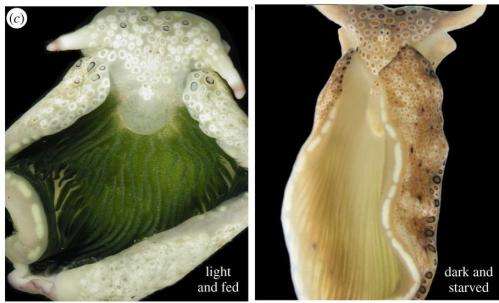November 20, 2013 report
Study shows 'solar powered' sea slugs can survive long term in the dark

(Phys.org) —A team of researchers from Germany and the Netherlands has found that at least two species of sea slug thought to be able to endure long periods of starvation by gleaning energy from the sun has found that the slugs can live for long periods of time without food and with or without sunlight. In their paper published in Proceedings of the Royal Society B: Biological Sciences, the team describes experiments they conducted with the slugs and then outline their findings.
The two types of sea slugs (Plakobranchus ocellatus and Elysia timida) survive by eating algae, but prior research has shown that the creature can survive very long periods of starvation. Because the slugs do not digest—at least right away—a specialized subunit of cells known as an organelle, that in the algae is responsible for photosynthesis, scientists have believed that the slugs were somehow gaining energy from the sun using the cells from the algae.
To test this theory, the researchers subjected several of the sea slugs to long periods of starvation under three different conditions. One group of the slugs was kept in the dark without food—another group was kept in a sunlit enclosure but was also not given any food. A third group was given a chemical that inhibits photosynthesis and was then kept in a lighted enclosure, but was not given any food either.
After 55 days the researchers pulled the slugs from their enclosures and studied them to learn if there were any differences among them. Surprisingly, the researchers could not find any. All the members of all three groups survived and all lost approximately the same amount of weight. A subsequent test showed just how durable the slugs really are—the researchers put six of them in a dark enclosure and didn't feed them for 88 days—all of the slugs survived and even appeared healthy.
The results of the study disprove the idea that the slugs somehow derive energy from the photosynthesizing cells they keep alive for long periods in their bodies. The researchers suggest that the slugs may instead be allowing the cells to remain alive for long periods of time, simply to eat them slowly as time passes. This means that the cells are apparently kept alive by the sun while in the slugs body—sort of an internal farming system, allowing the slugs to survive long starvation periods, which because they move so slowly, appears a necessary adaption to ensure survival.
More information: Plastid-bearing sea slugs fix CO2 in the light but do not require photosynthesis to survive, Published 20 November 2013 DOI: 10.1098/rspb.2013.2493
Abstract
Several sacoglossan sea slugs (Plakobranchoidea) feed upon plastids of large unicellular algae. Four species—called long-term retention (LtR) species—are known to sequester ingested plastids within specialized cells of the digestive gland. There, the stolen plastids (kleptoplasts) remain photosynthetically active for several months, during which time LtR species can survive without additional food uptake. Kleptoplast longevity has long been puzzling, because the slugs do not sequester algal nuclei that could support photosystem maintenance. It is widely assumed that the slugs survive starvation by means of kleptoplast photosynthesis, yet direct evidence to support that view is lacking. We show that two LtR plakobranchids, Elysia timida and Plakobranchus ocellatus, incorporate 14CO2 into acid-stable products 60- and 64-fold more rapidly in the light than in the dark, respectively. Despite this light-dependent CO2 fixation ability, light is, surprisingly, not essential for the slugs to survive starvation. LtR animals survived several months of starvation (i) in complete darkness and (ii) in the light in the presence of the photosynthesis inhibitor monolinuron, all while not losing weight faster than the control animals. Contrary to current views, sacoglossan kleptoplasts seem to be slowly digested food reserves, not a source of solar power.
Journal information: Proceedings of the Royal Society B
© 2013 Phys.org


















